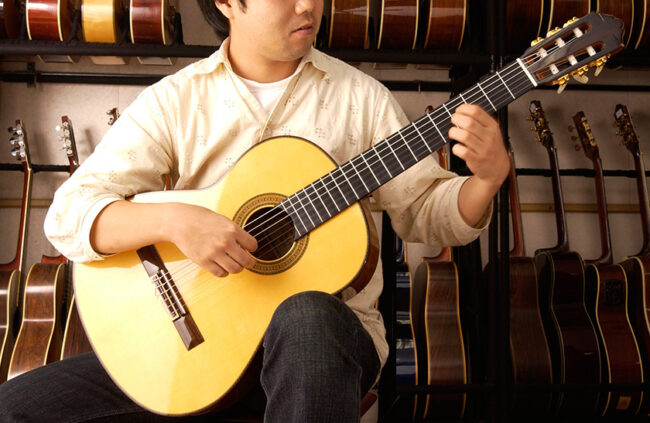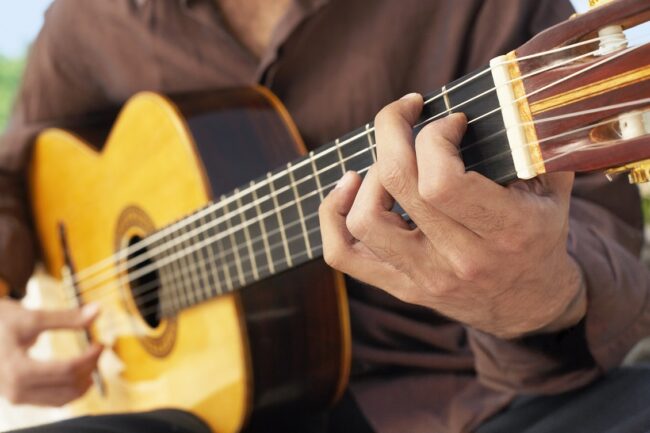Sight-reading on the guitar is well recognized as an ability that makes learning and performing music theory and music respectively simple and faster. After learning to read music notation, sight-reading is the study of performing it spontaneously and on cue.
However, it is also one of the “non-urgent” practice alternatives that are usually overlooked or put on the back burner.
In this post, we’ll see the Eight tips for guitar sight reading that will help any guitarist to improve their sight reading skills. You can also get organizational and sight reading material for your practice sessions at classicalguitarshed.com. Get ready to read music faster and with more ease!
What Is Sight Reading On The Guitar?

“Sight reading” means looking at a note in sheet music and playing it.
The best people who can play by ear can play with emotion, at the given tempo (speed), with a compelling correct rhythm, and with all the little swells and fades. And this is all because of music they just heard for the first time.
What’s The Benefit?
Guitarists are known for not being able to play by sight. And for a good reason: it’s hard to play the guitar well if you can’t read music. But those who do learn to read music enjoy the many benefits that come with it.
Practicing sight reading gives perks like:
- Learning music faster
- Able to play with other people and read music
- Have access to more music samples
- Pieces are easier to remember
- Better coordination between your hands and eyes to improve guitar performance
- Recognizing common parts and patterns in music
Learning to read music makes playing classical guitar easier and more fun. So it’s a great idea to spend a few minutes practicing this skill each time.
8 Easy-to-Follow Tips for Guitar Sight Reading Practice

1) Don’t look at your Hands, Pay Attention to the Notes
Even though learning new notes is hard enough, you must also ensure that your fingers are pressing the right strings. This keeps your eyes busy as they move from your hand to your notes to your neck.
Don’t look at your hands so that you’ll be able to focus on what you’re sight reading. And before you know it, your guitar playing will sound more natural and consistent.
2) Start Learning to Read Rhythms
Practice straight and swung 8th and 16th note rhythms by playing, clapping, or singing them to strengthen your sight reading ability. Both levels of rhythm should have syncopated beats. Also, practice triplets at different levels of rhythm (half, quarter, and 8th).
3) Play Written Exercises on All Strings
This will let you practice playing in positions other than those you’re currently proficient at on the neck. Avoid looking down at the guitar while playing to develop muscle memory for moving the neck and concentrate on interpreting the music.
4) Use a Metronome to Get Better at Reading
Beginners who try reading music for the first time tend to rush, making them sound like beginners. When you read, you need to nail the rhythms, key signatures, the notes, play in the pocket, and, one more thing, play with expression. When reading, dynamics, vibrato, and clear speech are still important.
5) Learn How to Read Notes Written on Ledger Lines

Many guitar players can quickly tell what notes are on each of the five lines of the staff. But when they have to figure out what the notes are on the ledger lines below and above the staff, they have trouble.
In standard tuning, the guitar goes from an E below three ledger lines (the transposed part) to a D two octaves above middle C, depending on the length of your guitar neck. That’s seven lines above the staff in the ledger.
6) Don’t Take Chords for Granted
Scales, arpeggios, and chords may not be very interesting, but they are important skills for reading music by sight. But it’s not enough to know how to strum through a guitar chord chart. When sight-reading, think about everything. It can be hard to read chords with added tensions or rhythmic notation, so think about these things.
7) Explore Different Genres
Classical manuscripts are a good place to start when you want to learn how to read on sight, but you never know what kind of genre you might come across. You might want to practice reading rhythms and grooves to each type of music.
Find and study big band charts, musical theater parts, and transcriptions of guitar parts and solos in Pop/Rock, Country, R&B, Latin, or any other style that might come up.
8) Try and Try Until You Succeed

Even though we always try to do our best, it’s impossible not to miss a note when reading music by ear. Of course, that’s not why your music performance by ear is so bad. Moreover, some errors are more serious than others.
Even though missing a note is a mistake, a wrong rhythm or bad counting can throw you off completely, so try to pay attention to the important parts of your performance. In any case, remember that it’s all part of your growth. Mistakes must be dealt with to move forward.
Final Thoughts
Playing the guitar by sight is a skill that can be learned with practice. Using the advice in this article, you can get better at reading music by sight and become a better guitarist. If you don’t notice results immediately away, don’t give up.
For every skill, practice and perseverance are necessary. Regular practice will help you improve your ability to read by sight. We hope you found this post useful and learned new ways to improve your guitar playing.
